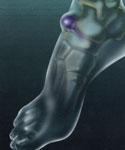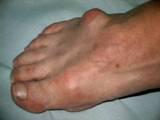Ganglions


A ganglion is a sac of fluid, arising from a joint or a tendon. They usually occur on the wrist or the foot. The exact cause is unknown, but they are thought to be due to weaknesses in the lining of the tendons or joints, allowing bubbles of synovial fluid (lubricant) to balloon out.
They are often painful initially as the tissues are stretched, but this settles as they stop growing. They usually fluctuate in size and can disappear altogether. Ganglions are not dangerous and are often asymptomatic and do not require surgery unless they cause significant discomfort. In fact, surgery is not particularly successful and there is a recurrence rate of 20% after surgery. Therefore, I often recommend avoiding surgery unless the ganglion causes particular discomfort or is unsightly. Unfortunately, there is no reliable non-operative treatment and ganglions aspirated by needle often return.
The surgery (or resection as it often termed) is quite straightforward performed through an incision over the ganglion. The sac is traced back to its origin and removed.
Depending upon the size, position and depth it can be performed under local or general anaesthetic and is a day surgery case where you may go home as soon as you are able.
Risks of surgery
Nerve damage
There are often cutaneous nerves overlying the ganglion and these are at risk of damage, which may be temporary or permanent. If a nerve is damaged, it can occasionally for a neuroma – a painful nerve stump, which can be very difficult to treat.
Infection
There is always a risk of infection with surgery. The best way to reduce your chances of acquiring an infection is to keep the foot elevated for 7 days. If there is an infection, it normally resolves with a course of oral antibiotics.
Recurrence
This is common, in up to 20% of cases.
Scarring
Naturally, the operation will leave a scar. Rarely, the scar can be permanently tender or painful.
Recovery from surgery
As with all foot surgery, it helps recovery to keep the foot elevated as much as possible to reduce swelling and prevent infection.
Depending on the position of the surgical site, you will probably wear comfortable or a post-op shoe for a few days. Dressings can be reduced at 3-4 days and there will be a follow up after 2 weeks for removal of sutures.
Activity and time off work
Unless you have a role that involves particular physical effort or a lot of standing and/or walking, you may return to work as soon as comfortable. In most cases it is possible to return to reasonable activity between two and six weeks after surgery.